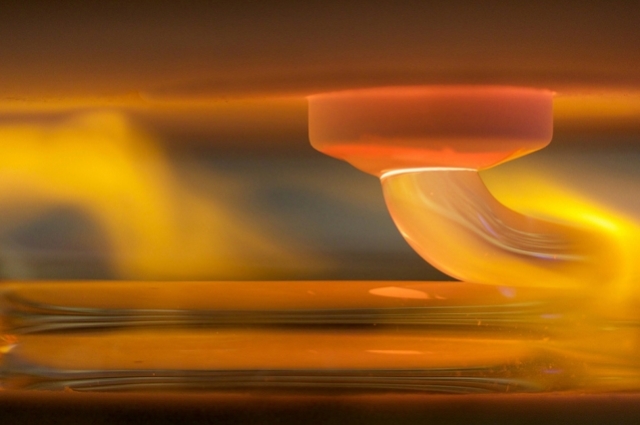Sep 14 2015
MIT researchers have discovered a novel method to 3D print strong, transparent glass structures, taking the existing 3D printing technology to a completely new level.
 The glass 3D printing process.(Photo: Steven Keating)
The glass 3D printing process.(Photo: Steven Keating)
Originally, it was MIT that had formulated 3D printing technology, and since then, this technology has gained immense attention and expanded to include numerous types of materials such as metals and plastics. The rapid progress has also brought the price of 3D printers down, making them a household consumer product.
Neri Oxman, an associate professor at the MIT Media Lab, Peter Houk, director of the MIT Glass Lab, MIT researchers John Klein and Michael Stern, and six others have involved in the development of the latest 3D printing system. The team illustrated the method in the Journal of 3D Printing and Additive Manufacturing.
Various research teams have been unsuccessfully trying to 3D print glass items. The primary hurdle was the very high temperatures required for the material to melt. Some researchers used the sintering method to meld together small glass pieces at a lower temperature. Objects created in this manner were optically cloudy and not strong, thus lacking the two key features of glass – transparency and strength.
However, the MIT team was able to create printed glass items with those features using its high temperature system. Similar to the commercially available 3D printers, the newly developed system could print designs with the help of computer-assisted design program. Therefore, minimal human intervention is required to create end products.
The MIT method requires the molten glass, which is collected from a traditional glassblowing kiln, to be filled inside a hopper in the top of the new system. On completion, the end product assembled on a moving platform has to be cut away.
The hopper and a nozzle are maintained at approximately 1900°F, which is way above the temperatures generally used in other 3D printing. The glass is extruded via the nozzle to create an object. As the molten glass flows out of the nozzle, it looks like honey and forms coils on the platform, where it cools and hardens.
The MIT researchers however faced a challenge during this process. They had to keep the glass filament hot enough so that the subsequent layer would stick to it, but, at the same time, the heat should not be too high that the structure might disintegrate into a formless lump.
To solve this issue, the team created three individual components – the nozzle at the chamber’s bottom, the upper reservoir to hold the molten glass, and a lower chamber for the printed object to be formed. These components can be heated individually to the required temperatures.
Klein states that this whole research venture began as a project in an additive manufacturing course. He and a few others became keen on improving the concept after realizing the potential of the concept. However, the process was still time intensive and required a plenty of trial-and-error.
“Glass is inherently a very difficult material to work with,” said Klein. Temperature alters the viscosity of glass, and therefore, emphasizing the importance of accurate temperature control throughout the process.
Oxman explains that the unique process gave exceptional control over the shape of glass being produced.
“We can design and print components with variable thicknesses and complex inner features — unlike glassblowing, where the inner features reflect the outer shape,” Oxman explains. For instance, she adds, “We can control solar transmittance. … Unlike a pressed or blown-glass part, which necessarily has a smooth internal surface, a printed part can have complex surface features on the inside as well as the outside, and such features could act as optical lenses.”
Oxman believes that the process is likely to be used to produce much bigger structures.
“Could we surpass the modern architectural tradition of discrete formal and functional partitions, and generate an all-in-one building skin that is at once structural and transparent?” she questions. “Because glass is at once structural and transparent, it is relatively easy to consider the integration of structural and environmental building performance within a single integrated skin.”
Houk offers a few more tips to drive the research to the next level. One is to add pressure to the device using compressed gas or a mechanical plunger, so as to generate a more even flow, which will provide extruded glass filaments with a more even width.
Previously, the MIT team has showcased using colors in the glass in limited experimentation.
Klein states that the new printing system was achieved due to multidisciplinary efforts, which was made possible by MIT’s policy of flexibility across departments. For this particular research, the departments involved were from the Media Lab, the Department of Mechanical Engineering, and the MIT Glass Lab, which is part of the Department of Materials Science and Engineering.
The research team also comprised Markus Kayser, Chikara Inamura, and Shreya Dave from MIT, James Weaver from Harvard University’s Wyss Institute for Biologically Inspired Engineering, and Georgia Franchin and Paolo Colombo from the University of Padova, Italy.